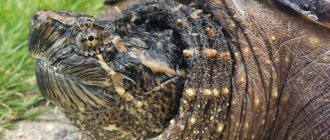Description of the species
Red-eared turtles in nature reach 30 cm in length (based on the shell), but when kept at home they rarely grow to that size. Females are significantly larger than males. The shell of juveniles is bright green, but as the turtle matures it becomes brown or olive in color with patterns of bright yellow stripes.
The head, neck and paws of the animal are decorated with a series of white and black stripes. The species got its name due to the bright red spots near the eyes. These “ears” can also be deep orange or rich yellow. It is thanks to its bright appearance that the red-eared turtle has become one of the most popular exotic pets.
She prefers to lead a sedentary lifestyle, but swims very quickly in the water and is extremely curious. May hiss and snort, expressing his displeasure and anxiety. When defending its life, it can inflict serious wounds with the sharp claws of its hind legs. In the cold season, a phenomenon called suspended animation, or hibernation, occurs for red-eared turtles.
Selection and transportation
Small, about 2.5 centimeters long, the young turtle looks very impressive. The stripe running from the eyes to the neck is bright red, the shell is rich green on top, and lemon yellow underneath. Moreover, it is all “painted” with black and yellow stripes, which are intertwined into a complex pattern - you want to buy such beauty without hesitation. However, experienced breeders recommend purchasing one-year-old individuals, 5-6 centimeters long, that have “proven” their viability.
For an older red-eared slider, the description will not be so impressive - over the years the colors become less vibrant. By the way, you can determine its age by simply measuring the length of its shell with a regular ruler. With proper care, it gains 2.5-3 centimeters in length per year. The red-eared turtle reaches its maximum size at about 6 years of age. By this time, males reach 17 centimeters, females are 3 centimeters more
Now let's see what else is important to consider when choosing a ward:
- The shell should be oval, slightly convex on top, without deformation. Its too curved shape indicates rickets.
- Take a closer look at how your potential pet behaves in the water. For example, if a red-eared turtle swims sideways, refuse to buy it - this is a sign of pneumonia, which is too troublesome to treat.
- Carefully inspect the skin, eyes and claws - the latter should not delaminate. The soft surfaces must be healthy, that is, without signs of peeling, cracks or abrasions. The eyes are wide open and shiny.
Another important question when choosing a pet is how to determine the sex of a red-eared slider if you decide to get a pair. You can distinguish a male from a female once they reach 2 years of age. At this age, “boys” begin to form a more concave lower part of the shell, grow long claws on the front legs and develop a genital organ hidden in the thickened base of the tail. The latter in “girls” is noticeably shorter and thinner; in addition, “ladies” are larger and the anus is located closer to the shell.
After the choice is made, another task arises, namely the question of how to transport the red-eared slider so that it does not get too stressed. First of all, consider the time of year and travel distance:
- If the journey takes no more than a day, a cardboard box with holes for ventilation and soft bedding is enough. For example, a simple cotton towel will do.
- In the summer heat, it is better to take a spray bottle of water with you and spray your “passenger” as needed. In winter, long-term transportation is not recommended. Maximum 4-5 hours in an insulated container heated by your body temperature - that is, in your bosom.
- If longer transportation is necessary, it is best to get a small aquarium made of lightweight plastic. However, keep in mind that a water turtle can drown without access to land. Therefore, you need to either put an “island” in a container of water, or regularly pick it up in your hands.
So, the house was prepared as comfortable as possible, healthy pets were selected and brought in - the main part of the work was done. It remains to figure out how to care for the red-eared turtle so that it continues to be healthy. By the way, when choosing this reptile, keep in mind that with proper care it can live for 40 years and become a real member of the family.
How long does the red ear live and where does it live?
This type of turtle can rightfully be considered a long-liver. In favorable conditions, life expectancy is 40 years. An interesting fact is that the red-eared turtle has a high level of intelligence, not typical of other reptiles. These animals are very sensitive to vibrations and their behavior can warn of an impending earthquake or storm. When choosing food, the red-eared turtle first focuses on the color, and only then on the smell and taste of the object.
These reptiles are widespread in nature. They can be found in their natural environment in Central and South America, Israel, South Africa, Spain and even Great Britain. But in Australia, this species is officially recognized as a pest, since it destroys local endemics. The red ear lives in shallow ponds and lakes, and in other bodies of water with swampy shores.
Keeping at home
Keeping this exotic animal turns out to be much more difficult than initially thought. These turtles spend most of their time in the water, although they need land. For one adult, an aquaterrarium with a volume of 120-150 liters will be comfortable, while land should occupy no more than 25% of the total area. On the improvised bank, special soil or crushed stone should be poured, making a gentle rise. The turtle's shell must fit completely in the water so that the animal can easily roll over onto its back and back.
For this type of amphibian, the optimal temperature is 25-30 degrees Celsius. When the temperature drops to 20 degrees, hibernation may occur in red-eared turtles. The water in the aquarium is changed as needed, at least once a month. In order for the turtle to be healthy, it also needs to be provided with portioned irradiation with an ultraviolet lamp.
Setting up an aquaterrarium
For one ward you will need a 100-liter aquarium; a couple of different sexes will need a capacity of 150 liters or more. Next, we create the interior of the turtle’s home, taking into account the fact that land should occupy approximately 25% of the area of water. At the same time, let’s not forget our interests – the beauty of the aquaterrarium. If you wish, you can purchase an artificial shore at a pet store, but then you won’t get a real corner of wildlife. But you want not only to keep the red-eared turtle, but also to enjoy the whole composition.
We will be guided by the last condition:
- Place a large stone with a flat surface at the end of the aquarium. When calculating its size, take into account the distance from the top edge of the future aquaterrarium - it should not exceed 40 centimeters.
- If the land slope is not gentle enough, you need to make a bridge to it from the water. Frequent, stable steps made of smaller stones or suitable driftwood without jagged edges will do.
- Next, we fill the soil not only at the bottom. Be sure to fill the space between the walls with stone and under the bridge. If this is not done, even though it is aquatic, the reptile may get stuck there and drown. The size of the soil also matters - red-eared turtles can swallow small pebbles and die.
- Living bottom plants will be quickly eaten. Therefore, it is better to choose emergent species with a root system located in ceramic pots or other reliable decorations at the bottom. For example, dwarf papyrus, water hyacinth and similar vegetation.
We will return to the small but important details of the interior later. Now it’s time to pour water into the almost finished aquaterrarium. Let's start with its parameters - temperature 22-28ºС, soft like peat, with neutral acidity
It is important to take into account the water level - it should be such that a turtle turned over on its back can find support on the bottom or decorations and independently return to its original position. Now regarding the required equipment:
- A good external filter for the red-eared turtle is very important because it feeds and defecates directly in the water.
- To heat the shore, you need a regular 40W lamp located directly above it. Stronger light bulbs can only be installed at a distance from land above fifty centimeters - otherwise burns cannot be avoided. The optimal temperature of a dry surface should not exceed 35ºС.
- Ultraviolet lamp for reptiles. It makes more sense to purchase it in a specialized store. It is better not to experiment with UV lamps intended for humans - the wavelength is completely different and the reptile’s body will not produce the vitamins necessary for the absorption of calcium.
- Thermostat to maintain a constant water temperature. When purchasing it, make sure that you need a model that is suitable for the aquaterrarium.
After the housing for the aquarium red-eared turtle is ready, it is recommended to let it stand without a pet for at least a couple of days. By the way, it needs to be positioned so that it is not exposed to direct sunlight. While the water is settling, there is time to go to pet stores in search of a “new home.”
What to feed the red ear?
When living in captivity, the diet of this species of turtle must include shrimp or any other small crustaceans. The red-eared turtle will happily feast on river snails, small pieces of fresh fish or meat, as well as bloodworms and earthworms. Turtles need to get enough calcium, otherwise shell diseases will begin. Poor appetite may indicate illness. Hibernation of red-eared turtles is also preceded by a decrease in interest in food.
It is worth adding plant foods: duckweed, seaweed, lettuce, spinach, cabbage. Due to the active growth of the body, young individuals need twice daily feeding. Turtles over two years old should be fed no more than three times a week. With a monotonous diet, it is worthwhile to provide feeding with special vitamins for turtles.
Why doesn't the turtle eat anything?
The obvious reason why a turtle does not eat and sleeps constantly may be dehydration and exhaustion of the body. If before the hibernation period the animal did not have time to empty its stomach, there is a possibility of kidney or liver failure due to improper wintering.
Interesting materials:
When and for what purpose was the Russian Ministry of Emergency Situations created? When did Irkutsk join Russia? When did Smolensk return to Russia? When was Koenigsberg Russian? When did Classicism emerge in Europe and Russia? When did Crimea become part of the Russian Empire? When is the Russia vs Czech Republic hockey match? When can you see the Milky Way in Russia? When did the bourgeois-democratic revolution begin in Russia? When did the first bourgeois-democratic revolution in Russia begin?
Hibernation of red-eared turtles
As mentioned above, this type of amphibian can fall into suspended animation - a state of reduced activity. Usually this period occurs during the cold season and is a protective reaction of the animal’s body to a decrease in temperature and a decrease in the amount of available food.
How does a red-eared turtle sleep at home? Considering the optimal conditions for keeping the amphibian and the lack of the need to get its own food, domestic red eared cats may not go into suspended animation at all. But since instincts can work at the subconscious level, in winter the turtle may be more lethargic and suffer from poor appetite.
If you notice this behavior in your pet, it is best to take him to the vet, as it may be caused by an illness. How long does a red-eared slider sleep? Typically, the period of suspended animation lasts one to three months, but at home it can be much shorter.
Is hibernation artificially induced in red-eared turtles? Yes, you can deliberately put an animal into a state of suspended animation. To do this, simply lower the temperature and reduce the lighting in the aquarium. However, it is best to consult with your veterinarian about the need for artificial hibernation before taking any action.
How to properly arrange a place to sleep
When the time for hibernation approaches for red-eared turtles, they begin to behave a little strangely. However, it is worth noting that the approach of this moment can be determined by the following changes that occur in the behavior and condition of the animal:
- The red-eared reptile begins to limit the number of its movements;
- The animal begins to yawn quite often;
- Characteristic clogging into a corner of an aquarium or terrarium. However, it may not show signs of activity at all.
If you notice all these signs in your animal, then first you should consult with a highly qualified veterinarian, who will initially determine what exactly is happening to the animal, and also rule out possible diseases that also have characteristic symptoms. If everything is fine with the animal’s condition, then these signs are precisely symptoms of the approaching wintering of red-eared turtles.
In order for the reptile to enter wintering mode with the least loss to health and during sleep it receives all the necessary nutrients, which in about two months will significantly increase the reptile’s diet. This increase contributes to an increase in body weight, which is a reserve for kicking. It is also worth considering that a reptile can lose almost half of its weight during sleep.
When the penultimate week begins before hibernation, it is worth completely limiting the animal’s diet, and immediately the day before going to bed, it is worth bathing it several times, this is necessary so that the animal can completely empty its intestines, thereby independently preparing itself for sleep.
Cooking the turtle itself is a mandatory process, but it is equally important to properly mark the place where the sleeping resident will spend the winter. Temperature readings should not exceed 6C
The best place for wintering is the basement, which is usually a fairly cold place, but nowadays it is quite difficult to find such cellars. It is worth accustoming a reptile to these temperature indicators gradually, since a sharp decrease in temperature indicators can lead to the unexpected death of the animal.
The next prerequisite is maintaining the correct humidity level. In the container where the red-eared turtle will sleep, it is necessary to lay natural bedding, ideally it should be moss or peat. This flooring should be constantly moistened, but care must be taken that it is not wet.
If all the conditions necessary for the proper hibernation process are carried out correctly, then the animal can remain in sleep mode for three to five months. However, it is worth noting that after the specified time has elapsed, the turtle must be properly taken out of sleep mode.
How and how long do red-eared turtles sleep?
Before you get yourself a pet - a red-eared turtle - you need to find out about the acceptable conditions for keeping it. Perhaps the very first thing people who have a pet want to know is how do red-eared turtles sleep and do they hibernate?
Turtle hibernation
Under natural conditions, animals simply need to hibernate due to a sharp drop in ambient temperature. If you observe the behavior of a turtle in nature, you can understand how much red-eared turtles sleep in winter. Under natural conditions, the period of sleep can reach five months, while the animal practically does not breathe. All body processes slow down, and fat accumulated during the waking period is spent on their implementation. At home, it is not recommended to create conditions for turtle hibernation. This is a very labor-intensive process - you need to deprive your pet of food for a week, then place it in damp moss and gradually reduce the temperature of the environment around it. As a rule, to the question - how long do turtles sleep at home in winter - there is only one answer: no more than three months.
Care, feeding and breeding
How long a red-eared turtle lives at home depends on its owner. Therefore, wishing your pet health and long life, follow the following feeding regimen:
- Young turtles, up to 2 years old, need to be given protein and plant foods daily in appropriate proportions of 3/1.
- For sexually mature four-year-old reptiles, feeding every other day and gradually reducing the amount of protein is sufficient.
- Elderly children over 10 years old can be given food once every 3 days. Moreover, the older you get, the less protein food you eat, gradually reducing it to nothing.
Now let's see what to feed the red-eared turtle in addition to balanced ready-made food:
- Lean meat, seafood and insects;
- Green vegetables such as cabbage, cucumbers or zucchini;
- Wild seasonal greens - plantain, dandelion leaves and nettles.
In addition to proper nutrition, careful care of the red-eared turtle is required, regardless of its age:
- Once a week, clean the bottom with a siphon and change 1/3 of the water.
- If necessary, wash the shell with a soft sponge. However, keep in mind that even a young turtle can bite hard.
- Turn on the UV lamp above the aquaterrarium for at least 3 hours a day.
Speaking of lighting, this begs the question of how the red-eared turtle sleeps and does it need hibernation? At a constant water temperature, it is not necessary for a domestic reptile to go into seasonal suspended animation. The duration of daily sleep on land may be determined by the conditions in which the pet is kept. For example, if the ward is not disturbed during the day, he will sleep well and will rustle about his business at night.
The red-eared slider's behavior may change during the breeding season. Moreover, at home this can happen at any time of the year. If you notice that the male is courting the female and she is intensively digging in the ground, trying to make a nest, help her. To do this, lower the water level to about 12 centimeters so that the female can rest her paws on the bottom and keep her head in the air - otherwise an ardent suitor may drown her during copulation.
Also take care of the nest - place a sufficiently large container with wet sand in the aquaterrarium. Then you can move the clutch to an incubator with a temperature of 26-30ºС and expect offspring after 2-4 months. By the way, you can “program” the sex of the babies - at a low temperature, males will hatch, a high temperature guarantees females, and a medium temperature will ensure a 50/50 ratio of both. In any case, the red-eared turtle, which has high intelligence for a reptile, will “appreciate” the efforts of the owner and over time will become completely tame.
How do red-eared turtles sleep?
How do turtles sleep at home and do they sleep at all? Of course, every pet simply needs physical rest. Many people want to know whether turtles sleep at night, complaining that the pet is unusually active at night.
Every turtle sleeps, only in some individuals the duration of sleep and its frequency may differ. It is quite possible that the pet does not sleep at night, but during the day, when no one is in the apartment, it sleeps. There are also turtles that sleep all night and try to rest several times during the day. Sleep can find your pet everywhere - both in water and on land. According to observations, most domestic red-eared turtles prefer to rest on land.
What determines the red-eared turtle's sleep?
First of all, a turtle's sleep depends on its activity. If you want to know how much turtles sleep, which do not show much activity during the day, the answer will upset you a little. Due to the fact that the turtle is inactive, less energy is spent, therefore, the pet needs less time to sleep. And vice versa, if your pet moves very quickly and is constantly busy with something, his sleep will be sound and long.
Also, the length of rest may depend on the sex of the turtle. Almost no one knows how to distinguish the sex of a turtle at a young age. In most cases this is impossible to do. Sex is determined in adulthood by the length of the tail (it is longer in males) and claws (in boys, the front claws are longer than the back ones). Also, sleep may depend on the occurrence of any disease. Some diseases of red-eared turtles can affect the disruption of the life cycle; the animal will either sleep too long, or vice versa – not fall asleep at all.
In principle, it is impossible to predict how much turtles sleep in different conditions. The duration of sleep is a purely individual factor, which depends primarily on the turtle itself, on its surrounding conditions and the rest it requires.
Sleep process in turtles
Every representative of the turtle world sleeps in its natural habitat. Reptile sleep has different types and durations. It is likely that the turtle is more active at night, but during the day, it can sleep peacefully. There are also individuals that can sleep at night, but at the same time, they also rest during the day. The pet can sleep both on land and in water. However, it is possible to answer the question of where red-eared turtles sleep. In most cases, these reptiles fall asleep on land.
How do turtles sleep?
Aquatic turtles (red-eared, marsh) can sleep both on land and under water. Sleep can also catch them during a walk, when the owner releases the animal from the aquarium. Therefore, you need to do this only for a few hours and periodically monitor your pet so that it does not get lost or get stuck in hard-to-reach places.
Most often, domestic red-eared turtles sleep on land. They climb onto the island, close their eyes, calm down and fall asleep. Some animals retract their head and paws into their shell, while others do not. They leave their head extended and simply close their eyes. This happens because they get used to a calm environment, the absence of predators and competitors.
However, the red-eared turtle can also sleep in water. A sufficient amount of air accumulates in her lungs, the supply of which lasts for several hours. The animal sleeps in the water, completely submerged there, or stands on its hind legs on the bottom of the aquarium, and rests its front legs on an island or other object. The pet can spend several hours in a row in this position.
How to tell if a turtle is sick or hibernating
As a rule, turtles kept in apartments do not need long hibernation. With the onset of seasonal cold, in October-November, the inhabitant of the aquarium may slightly change her behavior. She loses her appetite and sleep duration increases. But she is unlikely to hibernate, since the apartment is quite warm and light, and her own “home” is also additionally illuminated.
On the other hand, the behavior of a turtle, which its owners regard as hibernation, can be a dangerous and sometimes fatal disease. Therefore, if the apartment is warm, but the turtle is sleeping and not moving, you should sound the alarm. The first thing you need to do is touch it: if the head and limbs are extended and do not respond to touch, it is likely that the pet has died. When a living turtle gets into warm water, it will definitely begin to move its legs and try to swim. Another sure way to determine if a turtle is alive is to check the corneal reflex. If the eye does not react to the touch of any object, then the turtle has died.
When and how long do they sleep?
The answer to this question is ambiguous, since each animal develops its own habits over time. The duration of sleep and the characteristics of biorhythms depend on a number of factors:
- Gender
: Males have been found to sleep longer than females. Males can be distinguished by their more powerful paws and long tail. - Age
: young individuals are very active, they can swim around the aquarium all day, play, run around the room if the owners let them out. As a result, such turtles fall asleep for several hours, just like a person. They get very tired and can sleep all night. An old turtle often falls asleep on the go, it is slow and behaves calmly, so it requires less time to sleep. - Health status
: if the pet is cheerful and behaves as usual, nothing threatens its health. But sometimes the animal can become slow, falling into a kind of hibernation for 5-7 days in a row or more. Inexperienced owners may even think that the reptile has died, although in fact it is simply resting to recuperate. - Individual characteristics
: it is not the duration of sleep that depends on them, but biorhythms, i.e. time of falling asleep and waking up. There is no general law here: some turtles like to sleep during the day, after which they make noise all night. Others, on the contrary, fall asleep at night because during the day they are disturbed by light, noise from people, household appliances, etc.
Shore
The main point is that a standard aquarium is not suitable for it. In this case, an aquaterrarium is necessary, because the turtle requires both an aquatic environment and land. The volume should be at least 120 liters, and preferably about 200 liters. To many, such criteria seem excessive, but this is only while the turtle is small. However, over time it will grow, and the volume of water in the container must be sufficient for it to turn over in it.
As for the coastline, it is necessary so that the hero of our story can get out and warm up. The land line itself must occupy at least 25% of the entire aquaterarium. It is best to buy it in a store, but you can make it yourself. The main thing is that the island has sloping shores.
The shoreline should be illuminated with UV lamps, which will provide warming, because the temperature on the shore must be 10 °C higher than the water temperature. Too high is also undesirable, so as not to provoke overheating. The height of the lamp is about 25-30 cm. If it is installed lower, the pet will receive eye burns.
If your turtle sleeps too long or too little
In this case, you just need to observe the behavior of the animal. If the pet eats well, swims actively, communicates with other neighbors in the aquarium, i.e. behaves as usual, her health is safe. Typically, such periods of instability end after a few weeks, after which red-eared turtles spend the night in their usual rhythm.
If your reptile sleeps very little and is too active, it should be taken to the veterinarian. He will be able to clarify the reason for this behavior and prescribe sedatives and other medications. If turtles sleep a lot, literally for several days in a row, but wake up, feed, swim and fall asleep again, this is quite normal. If a sleeping turtle is not active at all, this may indicate the beginning of the development of the disease.
The only exceptions are those cases when the animal has gone into hibernation. This usually happens during the autumn-winter season, provided that the owner specially prepares the pet. To do this, reduce the temperature in the aquarium for several days in a row, significantly reduce portions or do not feed the turtle at all, etc.
Motives for long sleep
A considerable number of lovers often wonder why the turtle sleeps all the time? What are the reasons for such a long dream? The reasons for long sleep are:
A change of scenery. The cause of stress is not only moving to a new home, but also moving the terrarium to another room. During the adaptation period, which lasts a couple of weeks, the pet will get used to it and become active again.
In winter, install additional lighting. Reducing daylight hours. With the onset of autumn, the days become shorter, the reptile reacts to the reduction in natural light. The situation can be changed by installing additional lighting that will maintain the required day length.
Temperature in the terrarium. Elevated temperatures provoke forced cooling of the body, forcing the animal to climb into the ground or water. Reduced - automatically prepares the turtle for hibernation. By setting a constant, optimal temperature for the turtle from +26 to +33°, the pet’s condition is leveled out.
It is worth noting that the reptile sleeps quite often and for a long time, especially after a hearty lunch. But if this worries the owner, consultation with a herpetologist is necessary.











